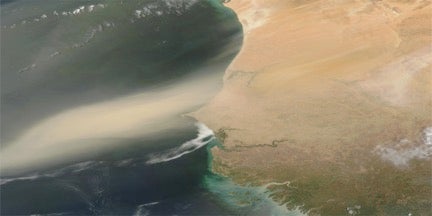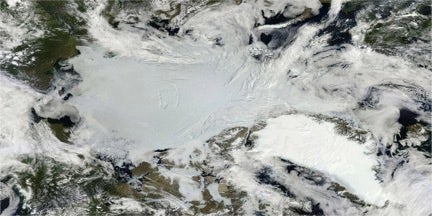The two projects were chosen as part of NASA’s Earth Venture Instrument program, which allows researchers to carry out short-term, focused investigations that accompany larger missions. NASA’s Jet Propulsion Laboratory (JPL) in Pasadena, California, will play a fundamental role in executing the projects.
The Earth Surface Mineral Dust Source Investigation (EMIT) is looking to analyze the mineral composition of Earth’s naturally occurring dust aerosols to see if they play a role in atmospheric warming or cooling. Little is currently known about the composition of these dust particles, making it difficult for scientists to determine their influence on atmospheric conditions.
To investigate the dust’s mineral compositions, EMIT will attach a hyperspectral instrument to the exterior of the International Space Station (ISS). As it flies over Earth’s deserts and other dust-rich areas, the instrument will break down the light emitted by surface minerals into its constituent wavelengths. This will enable researchers to detect which minerals are present in the aerosols and determine whether they are likely to impact our climate.
The EMIT team, led by JPL’s Robert Green, is made up of researchers with backgrounds in Earth system modeling, soil science, remote sensing of surface properties, and mineral measurement. EMIT’s hyperspectral instrument is partially based on NASA’s Moon Mineralogy Mapper instrument, which flew aboard the Indian Space Research Organization’s Chandrayaan-1 mission.
The investigation will use two CubeSat satellites, equipped with small infrared spectrometers, orbiting Earth’s poles. The sensors will measure the Arctic’s far-infrared emissions and note any changes that occur over time, whether they are daily or seasonal. Scientists will compare changes in thermal infrared emissions to changes in atmospheric conditions like cloud cover, sea ice, and the meltwater that sits on the ice’s surface. These correlations will give insight into ice-sheet melting and sea ice depletion, ultimately helping to determine why the Arctic is warming more rapidly.
The PREFIRE team consists of experts in Earth system modeling, Arctic ice, and remote sensing, and is led by Tristan L’Ecuyer of the University of Wisconsin-Madison. The Space Dynamics Laboratory in North Logan, Utah, and JPL are serving as mission partners for the investigation, with sensory technology based on the Mars Climate Sounder instrument that accompanied NASA’s Mars Reconnaissance Orbiter.
“PREFIRE and EMIT make innovative use of technologies first developed by NASA for planetary missions to address important, longstanding questions about Earth,” said NASA’s Earth Science Division director, Michael Freilich, in a press release.
The Earth Venture program stems from a 2007 recommendation by the Nation Research Council, who suggested NASA take on science-based investigations that have quick turnaround times. The first missions selected as part of the program, the Global Ecosystem Dynamics Investigation (GEDI) and the ECOsystem Spaceborne Thermal Radiometer Experiment on Space Station (ECOSTRESS), are set to launch between 2018 and 2019. They aim to measure changes in global vegetation and assess how it’s impacted by human and environmental factors.
Although NASA mainly focuses on answering the universe’s biggest questions, they’ve opened the door for researchers to answer smaller (but equally important) questions closer to home, too.











